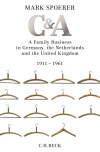C&A
A Family Business in Germany, the Netherlands and the United Kingdom 1911-1961
Zusammenfassung
The history of C&A is paradigmatic of the economisation and rationalisation of the production and sale of clothing since the late nineteenth century. Mark Spoerer describes the historical ups and downs of this Dutch family business from its beginnings in Germany through the post-war German «economic miracle». He investigates how the Brenninkmeijer family's traditional policy of recruiting new business leaders from its own ranks influences the company's long-term strategy. In 1841, the brothers Clemens and August Brenninkmeijer, who had gotten their start in the itinerant garment trade in Westphalia, founded a business in the Netherlands that would expand to Germany in 1911 and to Britain in 1922. Despite the difficulties the Brenninkmeijers encountered as foreigners, capitalists and Catholics in the Third Reich, they exploited those chances opened up by the Nazi regime, including the ‹Aryanisation› of property. After 1945, the company experienced furious growth with the rise of a new consumer society, developing into one of Europe's largest fashion retailers.
- Kapitel Ausklappen | EinklappenSeiten
- 1–12 Titelei/Inhaltsverzeichnis 1–12
- 13–27 Chapter 1 Introduction 13–27
- 28–74 Chapter 2 The Rise of the Brenninkmeijers (1600–1918) 28–74
- From Itinerant Traders to Store Owners
- The Expansion of C&A in the Netherlands
- New Social Classes, New Customers
- The Entry into Menswear
- Changes in Corporate Governance
- The Move into Germany in 1911
- C&A during the First World War
- 75–183 Chapter 3 The Development of C&A between the Wars (1919–1938) 75–183
- C&A Holland
- The Move into the United Kingdom in 1922: C&A Modes
- C&A in Germany
- The Weimar Republic (1919–1932): C&A on the Path to Expansion
- Years of Inflation: The Flight to Tangible Assets and Production
- Renewed Expansion: More Branches, New Customers
- Bold Advertising in a Competitive Market
- C&A Deutschland during the Great Depression
- C&A in the Third Reich (1933–1939): Between Traditional Values and Opportunistic Pursuit of Profit
- Areas of Conflict: Foreigners, Catholics and Capitalists
- Suits, Dresses or Uniforms? Expanding Production
- Expansion of the Branch Network and Political Resistance
- Charity and Protection Money: “Account A”
- Advertising in a Totalitarian State
- Properties Yes, Companies No: C&A and “Aryanisation”
- A Highly Profitable, Multi-National Enterprise
- 184–229 Chapter 4 Friend or Foe? A Multi-National Dutch Company in the Second World War (1939–1945) 184–229
- C&A Holland under German Occupation
- C&A Deutschland in the War Economy
- Retail during the War: Rationing instead of Advertising
- C&A as Producer: Wehrmacht Contracts, Production Contracted Abroad, Ghetto Production and Forced Labour
- C&A Modes in the “Blitz”
- Profits and Losses: C&A Businesses during the Second World War
- 230–313 Chapter 5 C&A during the Cold War and the “Golden Age” (1945–1961) 230–313
- Flight Westward: A Sputtering Start in the United States
- New Beginning in the Netherlands
- C&A Modes
- Total Loss and Reconstruction: C&A Deutschland in East and West
- East Germany: The Loss of All the Branches
- West Germany: Black Market and Currency Reform
- Expansion in the “Economic Miracle”
- Development and Expansion of Self-Manufacturing
- “Buying for Cash Means Savings at C&A” (“Barkauf ist Sparkauf bei C&A”)
- C&A and the Battle about Store Closing Hours
- Advertising in the Staid Years of Reconstruction
- Golden Years: C&A in the Post-war Boom
- 314–356 Chapter 6 Family or Market? The Succession of Ownership, New Leadership Development and Corporate Governance at C&A 314–356
- The Problem of Succession in the Terminology of the Principal-Agent Model
- Abundance of Children, Education, Internal Competition and Unitas as Answers to the Problem of Succession
- Education for Future Leaders
- Careers in “the Firm”
- Female Managers
- From jongelui to ondernemers
- Retirement at Age 55
- Unitas
- Corporate Governance à la C&A: The Institutional Implementation of Unitas
- Taking Decisions within the Group of Owners
- Transformations in Corporate Group Structure
- 357–366 Chapter 7 Summary 357–366
- 367–479 Appendices 367–479
- The Unitas Principles
- Tables
- Brenninkmeijer Family Members Employed at C&A
- C&A Entrepreneurs in the Netherlands, Germany, the United Kingdom and the United States, 1911–1961
- Number of Employees at C&A Deutschland and C&A Modes
- List of C&A Group Firms
- Openings of C&A Branches in the Netherlands, Germany and the United Kingdom, 1841–1961
- Turnover, Profits and Profitability of C&A Groups in the Netherlands, Germany and the United Kingdom, 1841–1961
- Market Shares of C&A Retail Firms in the Netherlands, Germany and the United Kingdom, 1930–1961
- Donations of C&A Groups in the Netherlands, Germany and the United Kingdom, 1926–1961
- Exchange Rates of the Guilder, Mark and Pound to the US Dollar, 1913–1961
- Documents
- Letter from C&A Head Office to Hermann Göring, 15 October 1937
- Letter from Franz Brenninkmeijer to managers at C&A Deutschland, 4 September 1939
- Letter from Dr. Rudolf Brenninkmeijer to staff at C&A-Deutschland drafted into military service, 16 July 1941
- Letter from Franz Brenninkmeijer to staff at C&A-Deutschland drafted into military service, 2 December 1942
- Indices
- List of Abbreviations
- List of Figures
- List of Tables
- List of Sources
- Bibliography
- Subject Index


